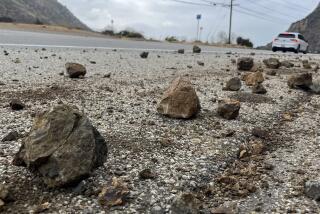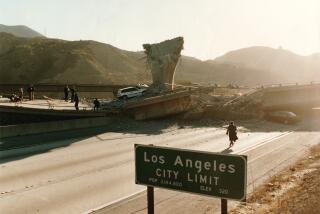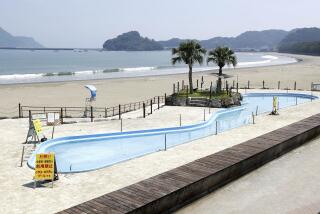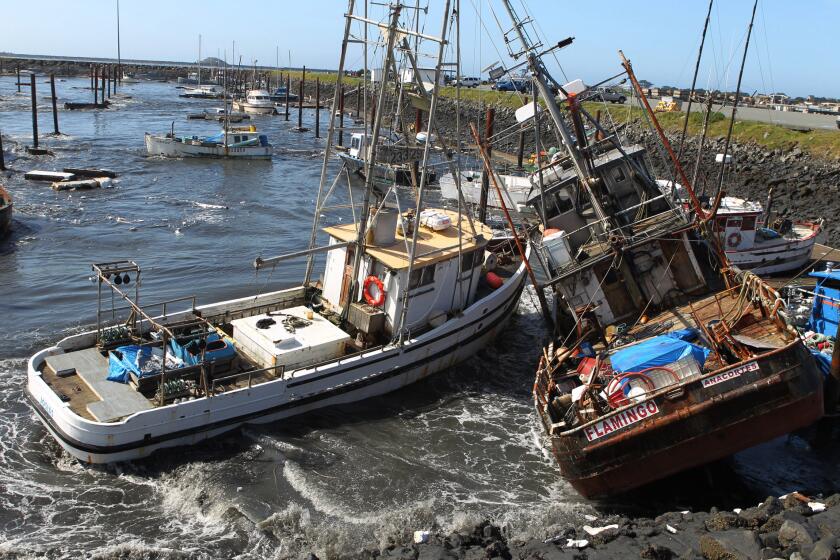COLUMN ONE : Predicting the Big One a Big Zero : Unique in the world, Japan persists in trying to forecast earthquakes. Society demands it despite lack of success and at the expense of other research.
- Share via
TOKYO — At the command center on the seventh floor of the Japan Meteorological Agency building, men in blue coats and sandals keep vigil over banks of computers flashing endless electronic pulses. Every subterranean hiccup emanating from Tokai, a region 90 miles to the southwest and site of the world’s most ambitious earthquake-prediction experiment, is instantly analyzed. The men are on 24-hour quake watch. They are looking for the Big One.
An eerily calm spot in a nation of ferocious temblors, Tokai, scientists suspect, may be the epicenter of Japan’s next major jolt, one that could strike with the power of the largest atomic weapon ever detonated.
The plan is simple: Detect any coming quake in advance and warn the public in an effort to avoid the disastrous results of the recent temblor in Turkey, or the horrendous tolls of past Japanese quakes. If sensors spotted something peculiar, an alarm would sound and a panel of experts--called the “six wise men”--would be summoned to render a determination. On their advice, the head of the meteorological agency would notify the prime minister, who would notify the Cabinet before warning the public to take cover.
But so far, the wise men have never been summoned. No quake warnings have been issued, although there have been a few false alarms. Japan has not yet successfully predicted an earthquake. In fact, a growing number of experts say it probably never will. Critics say quake prediction is a pipe dream because the nature of quakes is as impenetrable to science today as it was 120 years ago, when forecasting efforts began.
A committee of 170 seismologists called the Geodetic Council advised the Ministry of Education, Science, Sports and Culture last year that future research should move away from trying to predict quakes in the short term. The council acknowledged that, despite an expenditure of $1.3 billion over three decades, Japan’s quake-prediction program has produced few results in pursuit of a goal that, for the moment, is unobtainable.
But the money continues to flow to quake-prediction efforts, a fact that tells more about social forces at work within the disaster-prone archipelago than about what’s happening deep inside the Earth’s crust. Critics say the situation illustrates how money, politics, bureaucratic inertia and sheer fear of natural disasters can converge to shape scientific inquiry and push it in directions many researchers prefer it would not go.
“The quake-prediction story in Japan is symptomatic of larger problems of the Japanese system of government in general. . . ,” said University of Tokyo seismologist Robert J. Geller, an American. “Quake prediction in Japan is a mom-and-apple-pie value among people. Who can be against it? Scientists have misled the public over a long period of time into being overly optimistic.”
Few nations are as savaged by earthquakes as Japan. The archipelago sits at a dangerous crossroads where four continent-size slabs of Earth collide. About 1,000 quakes strong enough to be felt rattle the islands every day. All that bumping and grinding has fractured the Earth’s crust, resulting in 86 active volcanoes in Japan, or 10% of the world’s total.
In 1923, the Great Kanto Quake killed 142,000 people when it struck Tokyo. Every Sept. 1, the anniversary of that quake, millions of citizens mark the solemn occasion by participating in quake-preparedness drills.
The 1995 Kobe quake killed 6,400 people, caused $90 billion in damage, seriously crimped Japanese trade and affected the global economy. About 90% of the docks and cranes that unload ships at Kobe, a major port, were damaged.
“The bottom line is, the Japanese people expect us to predict earthquakes in the short term, but it is very difficult,” said seismologist Kenji Satake of the Japan Geological Survey. “We say it’s difficult, and they still expect scientists to go in that direction.”
Scientists Gravitate to Where Money Is
Scientists have also learned to follow the money.
Large government grants were long easily available to researchers who could show that their experiment might help predict quakes, said Kojiro Irikura, seismologist at the Disaster Prevention Research Institute at Kyoto University. While getting such funding is more difficult today, he said, quake-prediction research still consumes the lion’s share of the budget and staff at the institute. This comes at the expense of more traditional research such as discovering hidden faults or probing the mechanics of quakes.
“Scientists want the research money, the government people don’t want to spend too much on earthquake research, so the earthquake-prediction program was a way to make all parties happy,” said Tadao Minami, professor at the Earthquake Research Institute at the University of Tokyo. “If they say [the program is] not right, scientists will lose funding and the government must admit it was wrong, and they don’t want to acknowledge their mistake.”
Compounding the situation is the fact that quake-prediction studies undergo little scientific scrutiny in the form of reviews by independent peers. Also, Japan lacks a preeminent body of scientists with clout comparable to the U.S. National Academy of Sciences or National Research Council to verify scientific claims. The lack of checks and balances allowed quake-prediction work to continue uncontested for decades, scientists say.
Confidence in the quake-prediction program was seriously shaken by the Kobe quake, which struck without warning and damaged or destroyed 400,000 buildings. The jolt occurred in a region government officials and seismologists had said was at relatively low risk compared with the rest of Japan.
Today, scientists spend more time warning the public against undue optimism about their ability to predict earthquakes than about the disasters themselves.
“There are good reasons for being pessimistic,” said the University of Tokyo’s Geller. “Nothing that has been tried has succeeded. We don’t understand the physics of earthquakes. Quakes occur deep in the Earth where we can’t make direct measurements. . . . It is a very random and extremely complex process. We are in a very primitive state of knowledge.”
Japan’s quest to get a jump on quakes is remarkable in its scope. While the United States has given up on being able to predict quakes, Japan spends about half its $163-million annual seismic research budget on prediction.
Around the country, researchers have installed 500 seismic probes to measure the slightest jiggle underground. About 1,000 targets are being placed on the ground to enable satellites to measure movements as tiny as a few millimeters a year as the land surface wrinkles under pressure. In Shizuoka prefecture, where the Tokai quake is anticipated, scientists have studied fluctuations in hot springs, well water and land formations along the coast in a constant search for a telltale sign of an impending quake.
In Tokyo, the government sponsored a study to see if catfish get jumpy just before quakes. The idea was that the fish are sensitive to electromagnetic currents and might be able to detect subtle changes in the Earth’s magnetic field moments before a quake. The Japan Meteorological Agency once monitored clams on the bottom of Sagami Bay via video camera to see if they could detect gaseous changes in hydrothermal vents during a temblor.
“They are trying to do the most sensible job you could do on something that is almost inherently hopeless,” Geller said.
In California, the much-publicized attempt to predict an earthquake at Parkfield, a small town east of Paso Robles, failed. In 1985, the U.S. Geological Survey announced that there was a 95% chance that a magnitude 6 quake would strike by 1993. Like Tokai, Parkfield sits astride a fault that seemed to be behaving in a highly predictable manner. But the quake has not yet come. Today, most American scientists say they will not be able to predict temblors in the foreseeable future.
Stung by criticism, officials in Japan have spent the past four years trying to bring balance to the nation’s quake research program by broadening its mandate to include hazard reduction, searches for hidden faults, investigation of quake mechanics and installation of more seismic sensors. Staples of seismology, those efforts had previously languished, scientists say.
In addition, some government agencies and programs have changed names. For example, after the Kobe quake, the word “prediction” was dropped from the title of the earthquake research arm of the National Research Institute for Earth Science and Disaster Prevention.
But critics say there is less to the reforms than meets the eye. Quake prediction remains a high priority in Japan. Indeed, the ultimate aim of all Japan’s quake research programs is to develop an accurate prediction method as soon as possible, said Noriko Kamaya, earthquake researcher for the Japan Science and Technology Agency, which funds about half the nation’s quake research programs.
‘They Cannot Quit’ Providing Funding
Japan made prediction a national priority beginning with the government’s first five-year earthquake research plan in 1965. The mandate to predict an event at Tokai is contained in the 1978 Earthquakes Countermeasures Law. Both the plan and the 1978 law were developed at a time when quake prediction seemed attainable. Both set in motion prediction machinery that is now difficult to stop.
“In Japan, once government raises its hand to do something, it’s hard to change it. They cannot quit,” said Yujiro Ogawa, deputy director of the Asian Disaster Reduction Center in Kobe. “The basic problem is [that] since they adopted it as a law, they cannot stop using money on prediction. It is like a runaway train.”
Some scientists are still confident that quake prediction is possible, although there are fewer and fewer of them. A leading proponent is seismologist Kiyoo Mogi, the former head of the “wise men” and a professor at Nihon University. He was the only foreign scientist invited to review progress on California’s Parkfield experiment, and in December he published a book defending quake-prediction research in Japan.
“The question of whether we can predict quakes or not is very similar to whether we can cure cancer,” Mogi said. “Some cancers are curable, while others are not. People once had a perception that cancer was a deadly disease, that if you got it, you died, but nobody insisted cancer study should be stopped.
“Likewise, at a certain point in the future, we won’t be able to say we can predict earthquakes 100%, but the number of quakes we can predict may increase, and this is the right way to proceed. . . . If we say predicting a quake is impossible, all the efforts we made will be in vain.”
Researchers Study Earth for Clues
For now, all eyes are fixed on the Tokai region. Scientists in Japan say that if they can successfully predict a major earthquake, this is where they will do it. Tokai may be the most carefully monitored hunk of real estate on the planet, and it has all the ingredients of a disaster waiting to happen.
Four million people inhabit the region midway between Tokyo and Osaka on the Pacific coast. One of Japan’s biggest nuclear power stations operates near Hamaoka on the Omaezaki Cape, about 30 miles from the fault. As soon as the shaking stops, surging tsunamis might hit the densely populated cities of Shizuoka, Yaizu and Numazu.
The region has been visited by powerful temblors before, some of which were preceded by peculiar geologic activity, including fluctuations in wells and hot springs and sudden tilts on the land surface. That gives Japanese scientists hope that predicting the quake might be as simple as keeping close watch for the signs to recur.
But therein lies the rub. Predicting a quake, if it can be done at all, will depend on the interpretation of many confusing signals emanating from underground. There is no agreement among scientists as to which ones signal that a big temblor is imminent.
That doesn’t deter the men in the command center at the meteorological agency building high above Tokyo. They keep the computers running that crunch incoming gigabytes of data in a ceaseless search for a sign of doomsday.
The work is monotonous, punctuated by such moments of terror as one that occurred in October 1997, when the alarm, which speaks in a reassuring female voice, announced: “There is a crustal deformation anomaly.” It was a false alarm from a broken strain meter, recalled Akio Yoshida, director of the quake-prediction division at the meteorological agency.
Yoshida has received many false alarms, often late at night. He must wear a pager round the clock. He was unable to care for his dying parents last year because to do so would have taken him too far from the earthquake command center.
“When that [alarm] happens, people really start to move fast. We feel very tense when that happens,” Yoshida said. “I try to be calm so I will not make any mistakes, but of course I’m worried. I’m very tired physically and emotionally.”
More to Read
Sign up for Essential California
The most important California stories and recommendations in your inbox every morning.
You may occasionally receive promotional content from the Los Angeles Times.










